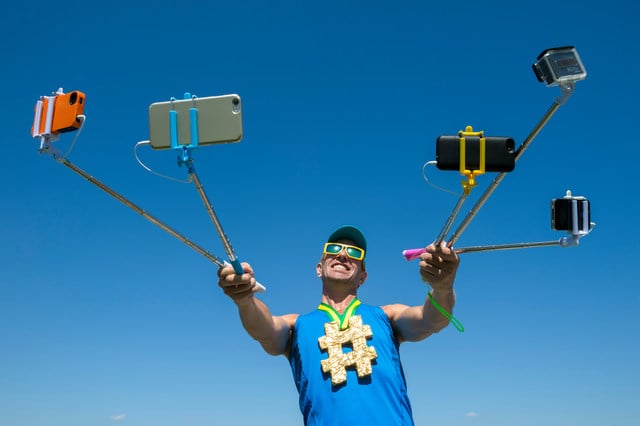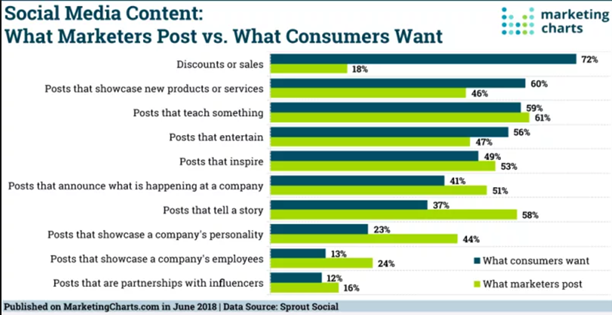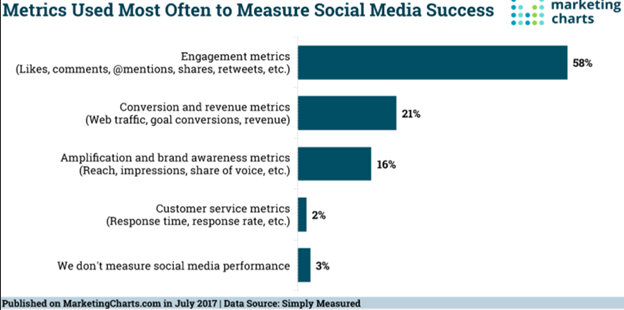
This is a topic that is debated daily.
WHAT SOCIAL MEDIA INCLUDES: For many, the term "social media" includes blogs, microblogs, photo & video sharing, podcasts, ratings & reviews, social games, social networks, virtual worlds, wikis, etc.
Be cautious when reading 'social media'; definitions vary.
BEGIN WITH THE END IN MIND: Each company/team must define its success. Since social media is a mechanism/tool a bit like a Swiss army knife, it can be many things, used in many ways.
 WHO: Do not target “everybody and anybody.” In fact, not everyone you serve will use social media platforms such as LinkedIn. They will find other venues/platforms to hang-out in. If your objective is to serve cyber security experts and staff, what is relevant and interesting to them will NOT be of much interest to the rest of the world. Keep in mind the human element, where even cyber security experts/staff like to laugh, celebrate, be recognized and cheer.
WHO: Do not target “everybody and anybody.” In fact, not everyone you serve will use social media platforms such as LinkedIn. They will find other venues/platforms to hang-out in. If your objective is to serve cyber security experts and staff, what is relevant and interesting to them will NOT be of much interest to the rest of the world. Keep in mind the human element, where even cyber security experts/staff like to laugh, celebrate, be recognized and cheer.
The attached list of cyber security job titles can be a first clue about who to listen to, where to invest your time.
LISTEN & UNDERSTAND: The most significant value of social media is the opportunity to listen and understand what is essential. We know the foundation of good leadership is listening first.
A REALITY: Your company's social media platforms likely have low followers and engagement vs personal accounts. Specific employees or leadership on the team will have more connection and engagement than your 'brand.'
For your "brand," create the story - If you are about to send equipment to Mars, or are saving lives during a disaster… these are moments to say “hey!” and potentially lead others to follow your lead with helping those in need.
ROI: Since social media, tools are in the hands of humans, they are inspired to share (or not). "Word of Mouth" now includes "Word of Click." ROI can be measured but requires outstanding planning and a serious commitment to execution and measurements at every step. The steps go from stranger to customer and on to referrals/advocates.
But also consider… what is the ROI of a warm greeting, a handshake, giving someone advice, or a tip?
ADDITIONAL RESOURCES: To look at more sides of the proverbial elephant and create more common ground for your team, there are additional resources below (data and graphs).
YOUR COMPANY
What does your team believe?:
- Our competition actively posts on social media, so our company should also post.
- Our inner circle (fans) and employees have said, "we should use social media."
- We are only Interested in posting on social media, not for engagement, customer support, or as a sales tool.
- We want to reflect the 'personality' and values of our company.
- We want to see our company as the brand's priority, not the individuals.
Pros & Cons
Pros of posting:
- When people search to 'vet' a company, they will glance at social media platforms to get a sense of character, expertise, and style.
- Employees, customers, and fans may see the social media posts, which gives them warm fuzzies or spur them on to pursue 'the mission."
- Should thought leadership be shared on social media posts, others might refer to the posts with "they said…".
- When people search for a business online, social media websites might rank higher in search engines. (Especially true for small businesses with no/low inbound marketing strategy.)
- Relationships are supported when recognizing people/teams/companies on social media.
Cons of posting:
- Social media platforms' company pages limit visibility as they continue to change their systems. Social media platforms are public companies focused on selling advertising, and "we" are the content or provide content. REALITY: Those who like/follow pages may not see posts.
- There are different types of social media postings. An essential type of post that improve connections is "engagement posts":
- "Engagement posts" are direct interactive posts that include recognition, celebration, and encouragement. They require understanding of specific clients, prospects, vendors, fans, and inner circle.
- "Engagement posts" require more time and investment to listen before engagement.
The following graph from Marketing Charts is based on research from Sprout Social. It shows the disparity between what people want vs. what marketers post on social media.

Social Media Posts - What to post
Scheduling social media posts could/should include the following types of social media posts:
- Share the story (created by your team, or others)
- Celebration
- Recognition (of individuals or companies)
- History – 100 years ago
- Quotes to inspire
- Warnings (Big news to say the sky is falling)
- Predictions
- Invitations to events
- Recommendations
Details about the social media posts:
Most social posts will include a link, but it is not always required.
@mentions of individuals and companies are an extremely important way to engage. “Social” is about “connection!”
Stock images are bad, bad, bad. Select more unique stock images, edit the images/graphics. Use REAL photos/videos. Canva, Animoto, Snagit and other tools are available so “anyone” can get it done. (it is odd how many take the lazy way and use generic images that have no relevance or impact.)
Sharing websites with good titles and meta descriptions usually does most of the work. Social sharing tools will pick up the title, image and meta text… but be ready to edit the titles or add your own image.
Create unique #hashtags specific for your brand. Each #hashtag is a link in LinkedIn that helps you build a content inventory of similar articles. By using generic #hashtags, your post is added to the thousands of other posts and gets lost with others who also have the "post and hope" strategy.
The more the social posts appear predictable, ubiquitous, self-evident or not relevant to your connections… the more people will view it the same as a billboard.
The ultimate goal is not “more followers.” You want to connect with those you serve best. It is possible this group is a very small targeted group of people. Create the social posts for them.
POTENTIAL (monthly) DATA TO TRACK
Assuming there is low/no interaction or personalization, social media posts aim to create more visibility and improve brand awareness and availability.
"Reach"
"Audience Growth Rate"
"Published Posts"
"Interactions"
"Clicks"
"Shares"
"Impressions"
"Website Sessions" (visits to the website via social posts)
"New Contacts"
*** include personal/professional and company followers ***
These metrics can give a false sense of success. One million followers (reach) feel good but may not result in a cha-ching. There may be other benefits, as shared in the list of "pros." A company page reach may grow only 1% to 2% per month. Small organizations get frustrated with such results.
To track this data, software such as HubSpot can track this data and more.
Results vary depending on human interest and response. Much of the success also depends on how well you "listen first." This is especially important because the software platforms are not aligned with your goals.
As any leadership team evolves, new goals are set. Data will reveal more opportunities (and weaknesses), and adjustments to the plan can be made.
The chart below from Marketing Charts with research data provided by Simply Measured shows metrics used to measure social media success.

One last point about social media is regarding "the people" who hear a story and are inspired to share it with others:
It is more important to first invest in creating something remarkable, relevant, and helpful. (blog, event, news, video, graphic, story, photos, etc.)
THEN --- Social media allows people to spread a story quickly, without much of a push. And, of course, expectations change. What was amazing two years ago will barely get a glance today.
 Haystack Rock does not have a Twitter account, and yet thousands share the awesomeness they experience. They want to share the story, hoping others will also appreciate it.
Haystack Rock does not have a Twitter account, and yet thousands share the awesomeness they experience. They want to share the story, hoping others will also appreciate it.
We have touched on points without an extensive review hoping to spark new thoughts about the potential opportunities and possible misconceptions about social media.
Companies focused on B2B revenue can benefit from social media, but listening to the noise can be misleading.
THOSE MOST POWERFUL USE OF SOCIAL MEDIA
– is the one-to-one opportunity you have to make introductions and introductions to people. Private messages one-to-one to “make their day” with something that someone is interested in makes a huge long-lasting impact.
Social posting is a “post and hope” strategy with a “maybe someone will notice and like it!”
This is why you might hire a “social media manager.” They would be your “introduction and invitation” helper. They would become you, listen to those you serve, and offer something to start conversations. This social media manager can listen and reach out to 100 people per week. The “reach” from professional/personal social media accounts can grow at an astounding rate.
Use social media to listen and understand. Create content, tools, or events that make an impact. Share what you built with others. If you listened well enough and created something special with excellence, THEN tell the story… using social media, with posts and one-to-one messages.
P.S.
Cute kittens, puppies, and babies are difficult to compete with. They bring joy to humans. If you are to compete for attention, ask yourself, "Is the story we are sharing better than cute kittens, puppies, babies, and… Haystack Rock?"
Yes, it's true. Cyber security staff will like Haystack Rock more than content about hackers and IT security.